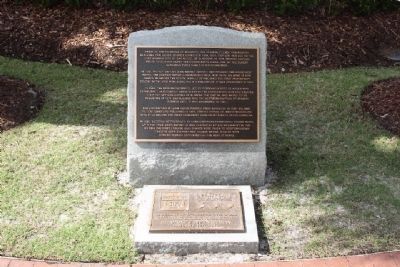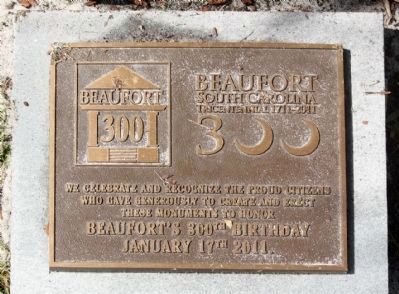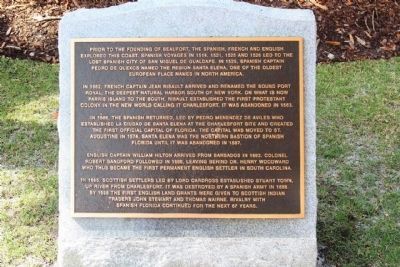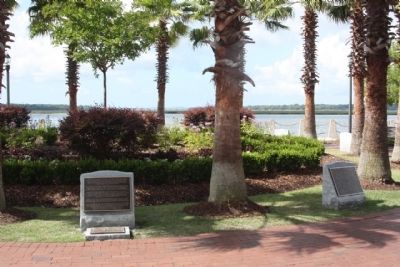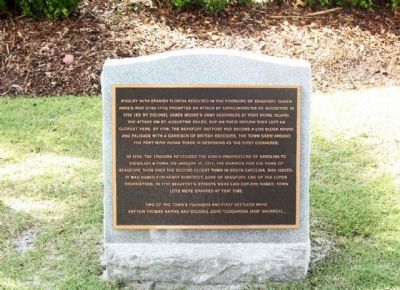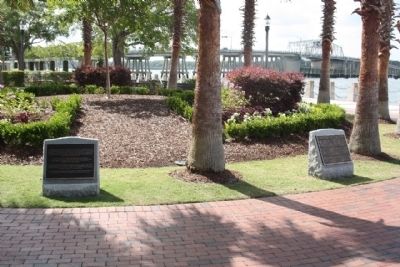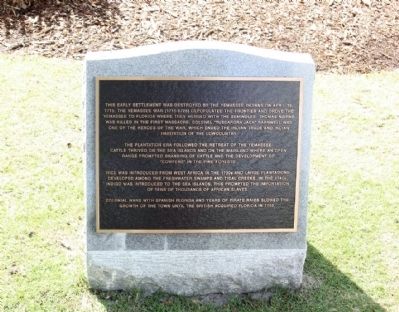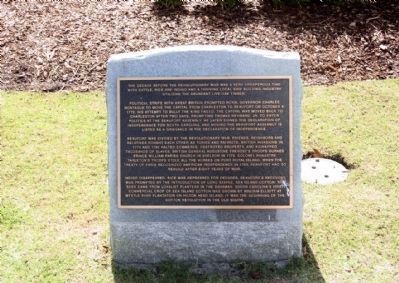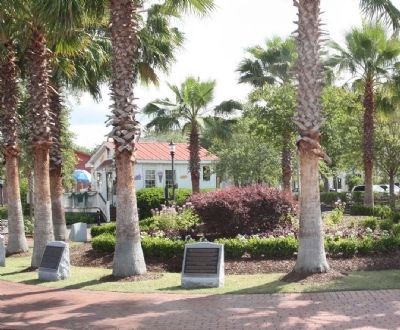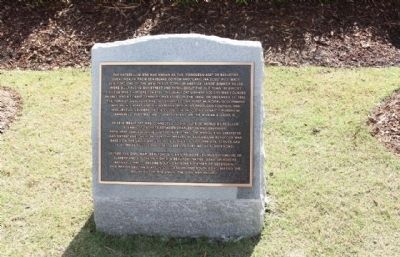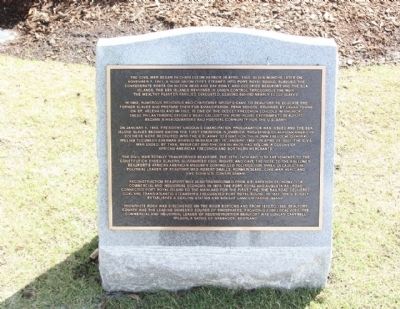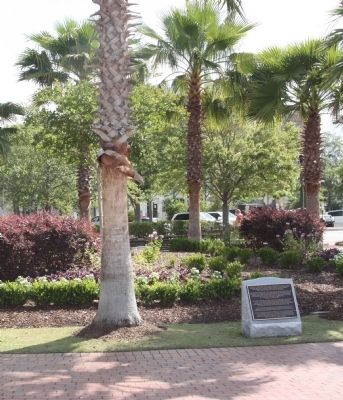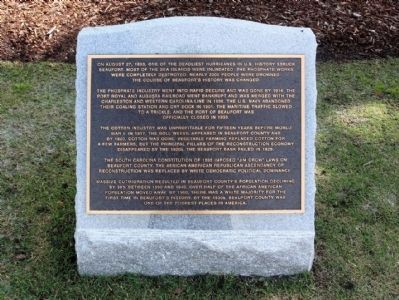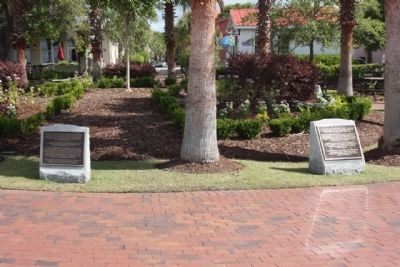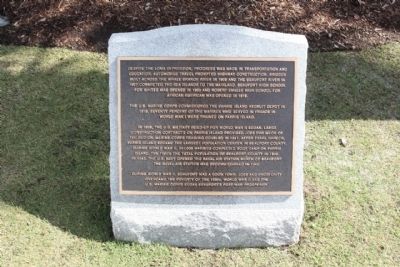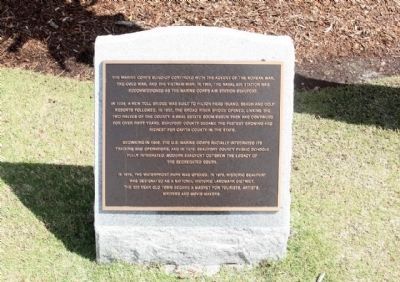Beaufort in Beaufort County, South Carolina — The American South (South Atlantic)
Beaufort South Carolina Tricentennial
1711-2011
300
Inscription.
300
We celebrate and recognize the proud citizens who gave generously to create and erect these monuments to honor
Beaufort's 300th Birthday
January 17th 2011.
(Plaque 1)
Prior to the founding of Beaufort, the Spanish, French and English explored this coast. Spanish voyages in 1514, 1521, 1525 and 1526 led to the lost Spanish City of San Miguel de Gualdape. In 1525, Spanish Captain Pedro de Quexos named the region Santa Elana, one of the oldest European place names in North America.
In 1582, French Captain Jean Ribault arrived and renamed the sound Port Royal, the deepest natural harbor south of New York. On what is now Parris Island to the south, Ribault established the first protestant colony in the New World calling it Charlesfort. It was abandoned in 1563.
In 1566, the Spanish returned, led by Pedro Menendez de Aviles who established La Cuidad de Santa Elana at the Charlesfort site and created the first official capital of Florida. The capital was moved to St. Augustine in 1574. Santa Elana was the northern bastion of Spanish Florida until it was abandoned in 1587.
English Captain William Hilton arrived from Barbados in 1663. Colonel Robert Sandford followed in 1666, leaving behind Dr. Henry Woodward who thus became the first permannent English settler in South Carolina.
In 1685, Scottish settlers led by Lord Cardross established Stuart Town, up river from Charlesfort. It was destroyed by a Spanish Army in 1686. By 1698 the first English Land Grants were givrn to Scottish Indian traders John Stewart and Thomas Nairne. Rivalry with Spanish Florida continued for the next 67 years.
(Plaque 2)
Rivalry with Spanish Florida resulted in the founding of Beaufort. Queen Anne's war (1702-1713) prompted an attack by the Carolinians on St. Augustine in 1702 led by Colonel James Moore's army assembled at Port Royal Island. The attack on St. Augustine failed, but on their return they left an outpost here. By 1706, the Beaufort Outpost had become a log block house and palisade with a garrison of British Redcoats. The town grew around the fort with Indian trade in deerskins as the first commerce.
In 1709, the traders petitioned the Lords Proprietors of Carolina to establish a town. On January 17, 1711, the charter for the town of Beaufort, then the second oldest town in South Carolina, was issued. It was named for Henry Somerset, Duke of Beaufort, one of the Lords Proprietors. In 1717 Beaufort's streets were laid out and named. Town lots were granted at the time.
Two of the town's founders and first settlers were Captain Thomas Nairne and Colonel John "Tuscarora Jack" Barnwell.
(Plaque 3)
This early settlement was destroyed by the Yemassee Indians on April 15, 1715. The Yemassee War (1715-1728) depopulated the frontier and drove the Yemassee to Florida where they merged with the Seminoles. Thomas Nairne was killed in the first massacre. Colonel "Tuscarora Jack" Barnwell was one of the heroes of the war, which ended the Indian trade and Indian habitation of the lowcountry.
The Plantation Era followed the retreat of the Yemassee. Cattle thrived on the Sea Islands and on the mainland where an open range prompted branding of cattle and the development of "cowpens" in the pine forests.
Rice was introduced from West Africa in the 1730s and large plantations developed among the freshwater swamps and tidal creeks. In the 1740s, Indigo was introduced to the Sea Islands. This prompted the importation of tens of thousands of African slaves.
Colonial wars with Spanish Florida and years of pirate raids slowed the growth of the town until the British acquired Florida in 1763.
(Plaque 4)
The decade before the Revolutionary War was a very prosperous time with cattle, rice, and indiago and a thriving local ship building industry utilizing the abundant Live-Oak timber.
Political strife with Great Britian prompted Royal Governor Charles Montague to move the capital
from
Charleston to Beaufort on October 8, 1772. His attempt to bully the King failed. The capital was moved back to Charleston after two days, prompting Thomas Heyward, Jr. to enter politics at the Beaufort assembly. He later signed the Declaration of Independence for South Carolina, and moving the Beaufort Assembly is listed as a grievance in the Declaration of Independence.
Beaufort was divided by the Revolutionary War. Friends, neighbors and relatives fought each other as Tories and Patriots. British invasions in 1779 and 1780 halted commerce, destroyed property and kidnapped thousands of slaves. British General Augustine Provost's troops burned Prince William Parish Church in Sheldon in 1779. Colonel Banastre Tarleton's troops stole all the horses on Port Royal Island. When the Treaty of Paris recognized American Independence in 1783, Beaufort had to rebuild after eight years of war.
(Plaque 5)
The Antebellum Era was known as the "Periclean Age" of Beaufort. Great wealth from Sea Island cotton and "Carolina Gold" rice made Beaufort one of the wealthiest towns in America. Large summer villas were built along Bay Street and throughout the old town. Beaufort College was chartered in 1795, the Beaufort Library Society was founded in 1803, and a female seminary was added in the 1850s. On December 17, 1803, the town of Beaufort was incorporated.
The first municipal government was an intendant and six wardens. Beaufort produced political and intellectual leaders of the Old South, including Senator Robert W. Barnwell, poet William J. Grayson, and writer William Elliott, III.
In 1819, Beaufort was connected to the outside world by regular steamboat packets between Charleston and Savannah. President James Monroe visited in 1819, and the Marquis de Lafayette was entertained here in 1825. The wealth of antebellum Beaufort was based on the value and labor of slaves. In 1850, the Sea Islands had 1,111 white people and 8,361 slaves occupying 151 plantations.
Before the Civil War, Beaufort's planters were leading defenders of slavery and Southern rights. A Beaufort native, Senator Robert Barnwell Rhett, became South Carolina's "Father of Secession." This region led the state into secession, and South Carolina led the South out of the Union. The Civil War ensued.
(Plaque 6)
The Civil War began in Charleston Harbor in April, 1861. Seven months later on November 7, 1861, a huge Union fleet steamed into Port Royal Sound, subdued the Confederate forts on Hilton Head and Bay Point, and occupied Beaufort and the Sea Islands. The Sea Islands remained in Union control throughout the war. The wealthy planter families evacuated, leaving behind nearly 10,000 slaves.
In 1862, numerous religious
and charitable groups came to Beaufort to educate the former slaves and
prepare them for emancipation. Penn School, founded by Laura Towne on St. Helena Island in 1862, is
one of the oldest Freedmen Schools in America. These Philanthropic efforts were called "The Port Royal
Experiment." Beaufort became a headquarters and hospital community for the U.S. Army.
On January 1, 1863, President Lincoln's Emancipation Proclamation was issued and the Sea Island slaves became among the first freedmen in America. Thousands of African American soldiers were recruited into the U.S. Army to fight for their own freedom. General William Tecumseh Sherman arrived in Beaufort in January, 1865. On April 26, 1865, the Civil War ended. By then, Beaufort and the Sea Islands had become a colony of African American freedmen and northern merchants.
The Civil War totally transformed Beaufort. The 13th, 14th, and 15th Amendments to the Constitution ended slavery, guaranteed civil rights, and gave the vote to the freedmen. Beaufort's African American majority controlled politics for three decades. The political leader of Beaufort was Robert Smalls, former slave, Civil War hero, and five-term U.S. Congressman.
Reconstruction Beaufort was also transformed from a plantation economy to a commercial and industrial economy. In 1873, the Port Royal and Augusta Railroad connected Port Royal Island to the mainland for the first time. The railroad delivered coal and Trans-Atlantic steamships frequented Port Royal Sound. In 1877, the U.S. Navy established a coaling station and bought land on Parris Island.
Phosphate rock was discovered on the river bottoms and from 1870 to 1893, Beaufort County was the leading domestic source of phosphates, providing 3,000 local jobs. The commercial and industrial leader of reconstruction Beaufort was Duncan Campbell Wilson, a native of Greenock, Scotland.
(Tablet 7)
On August 27, 1893, one of the deadliest hurricanes in U.S. history struck Beaufort. Most of the Sea Islands were inundated. The phosphate works were completely destroyed. Nearly 2000 people were drowned. The course of Beaufort's history was changed.
The phosphate industry went into rapid decline and was gone by 1914. The Port Royal and Augusta Railroad went bankrupt and was merged with the Charleston and Western Carolina Line in 1896. The U.S. Navy abandoned their coaling station and dry dock in 1901. The maritime traffic slowed to a trickle, and the Port of Beaufort was officially closed in 1933.
The cotton industry was unprofitable for fifteen years before World War I. In 1917, the Boll Weevil appeared in Beaufort County and by 1920, cotton was gone. Vegetable farming replaced cotton for a few farmers,
but the principal pillars of the reconstruction economy disappeared by the 1920s. The Beaufort Bank failed in 1926.
The South Carolina Constitution of 1895 imposed "Jim Crow" laws on Beaufort County. The African American Republican Ascendancy of Reconstruction was replaced by white democratic political dominance.
Massive outmigration resulted in Beaufort County's population declining by 38% between 1890 and 1940. Over half of the African American population moved away. By 1960, there was a white majority for the first time in Beaufort's history. By the 1930s, Beaufort County was one of the poorest places in America.
(Plaque 8)
Despite the long depression, progress was made in transportation and education. Automobile travel prompted highway construction. Bridges built across Whale Branch River in 1908 and the Beaufort River in 1927 connected the Sea Islands to the mainland. Beaufort High School for whites was opened in 1909 and Robert Smalls High School for African Americans was opened in 1919.
The U.S. Marine Corps commissioned the Parris Island Recruit Depot in 1915. Seventy percent of the Marines who served in France in World War I were trained on Parris Island.
In 1938, the U.S. military build-up for World War II began. Large construction contracts on Parris Island provided jobs for much of the region. Marine
Corps training doubled in 1941. After Pearl Harbor, Parris Island became the largest population center in Beaufort County. During World War II, 241,000 Marines
completed boot camp on Parris Island, ten times the total population of Beaufort County in 1940. In 1943,
the U.S. Navy opened the Naval Air Station north of Beaufort. The Naval Air Station was decommissioned
in 1946.
During World War II, Beaufort was a boom town. Jobs and prosperity overcame the poverty of the 1930s. World War II and the U.S. Marine Corps began Beaufort's post-war prosperity.
(Plaque 9)
The Marine Corps build-up continued with the advent of the Korean War, the Cold War, and the Vietnam War. In 1955, the Naval Air Station was recommissioned as the Marine Corps Air Station Beaufort.
Beginning in 1949, the U.S. Marine Corps racially integrated its training and operations, and in 1970, Beaufort County Public Schools fully integrated. Modern Beaufort outgrew the legacy of the segregated South.
In 1974, the Waterfront Park was opened. In 1973, Historic Beaufort was designated as a National Historic Landmark District. The 300 year old town became a magnet for tourists, artists, writers and movie-makers.
Erected 2011.
Topics and series. This historical marker is listed in this topic list: Notable Places. In addition, it is included in the Former U.S. Presidents: #05 James Monroe, and the Former U.S. Presidents: #16 Abraham Lincoln series lists. A significant historical month for this entry is January 1781.
Location. 32° 25.798′ N, 80° 40.254′ W. Marker is in Beaufort, South Carolina, in Beaufort County. Marker can be reached from Scott Street. located in Henry C. Chambers Waterfront Park close to the playground, Bay Street to Scott Street / Park entrance and the Beaufort River. Touch for map. Marker is in this post office area: Beaufort SC 29902, United States of America. Touch for directions.
Other nearby markers. At least 8 other markers are within walking distance of this marker. The Capt. Francis Saltus House (within shouting distance of this marker); Verdier House (about 300 feet away, measured in a direct line); The Sam Levin Building (about 300 feet away); Richard V. Woods Memorial Bridge (about 300 feet away); Great Fire of 1907 (about 400 feet away); Christensen-Fordham Building (about 400 feet away); Brigadier General Stephen Elliott CSA
(about 500 feet away); The Wallace House (about 500 feet away). Touch for a list and map of all markers in Beaufort.
Also see . . .
1. The Yamasee War (also spelled Yemassee War) (1715–1717), Wikipedia entry. was a conflict between British settlers of colonial South Carolina and various Native American Indian tribes, including the Yamasee, Muscogee, Cherokee, Chickasaw, Catawba, Apalachee, Apalachicola, Yuchi, Savannah River Shawnee, Congaree, Waxhaw, Pee Dee, Cape Fear, Cheraw, and others. Some of the Native American Indian groups played a minor role while others launched attacks throughout South Carolina in an attempt to destroy the colony. They killed hundreds of colonists and destroyed many settlements. Traders "in the field" were killed throughout what is now southeastern United States. Abandoning settled frontiers, people fled to Charles Town, where starvation set in as supplies ran low. The survival of the South Carolina colony was in question during 1715. The tide turned in early 1716 when the Cherokee sided with the colonists against the Creek, their traditional enemy. The last of South Carolina's major Native American foes withdrew from the conflict in 1717, bringing a fragile peace to the colony. (Submitted on August 5, 2013, by Mike Stroud of Bluffton, South Carolina.)
2. Robert Barnwell Rhett, Sr. , Wikipedia entry. U.S. representative (1837–1849), and U.S. senator (1850–1852). Extremely pro-Southern in his views, he split (1844) with John C. Calhoun to lead the Bluffton Movement for separate state action on the Tariff of 1842. Rhett was one of the leading fire-eaters at the Nashville Convention of 1850, which failed to endorse his aim of secession for the whole South .... (Submitted on August 5, 2013, by Mike Stroud of Bluffton, South Carolina.)
3. Robert Smalls (April 5, 1839 – February 23, 1915). was an enslaved African American who, during and after the American Civil War, became a ship's pilot, sea captain, and politician. He freed himself, his crew and their families from slavery on May 13, 1862, by commandeering a Confederate transport ship, the CSS Planter, in Charleston harbor, and sailing it to freedom beyond the Federal blockade. As a politician, Smalls authored state legislation providing for South Carolina to have the first free and compulsory public school system in the United States, and founded the Republican Party of South Carolina. He is notable as the last Republican to represent South Carolina's 5th congressional district until 2010. (Submitted on August 5, 2013, by Mike Stroud of Bluffton, South Carolina.)
4. 1893 Sea Islands hurricane, from Wikipedia. impact- The hurricane carried with it a heavy storm surge (16 ft or 4.9 m, according to Clara Barton), which caused great destruction along the coastline and offshore Sea Islands in Georgia and South Carolina. An estimated 1,000 to 2,000 people were killed (mostly by drowning), putting it on-par with 2005's Hurricane Katrina as the fourth deadliest hurricane in US history. St. Helena was estimated to have 6,000 Negroes living their while 2,000 were women. The majority of the Negroes owned land there and some rented. A lot of structures in that area were not elevated higher than 2 feet therefore they were covered by the first wave that went above the normal water mark (Submitted on August 5, 2013, by Mike Stroud of Bluffton, South Carolina.)
Credits. This page was last revised on October 16, 2020. It was originally submitted on August 4, 2013, by Mike Stroud of Bluffton, South Carolina. This page has been viewed 1,264 times since then and 25 times this year. Photos: 1, 2, 3, 4, 5, 6, 7, 8, 9, 10, 11, 12, 13, 14, 15, 16. submitted on August 4, 2013, by Mike Stroud of Bluffton, South Carolina.
